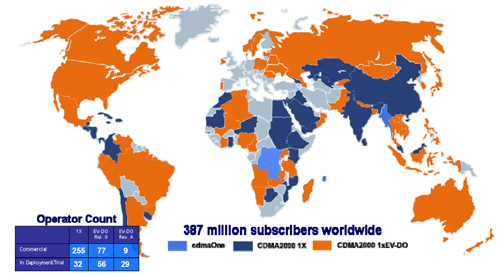
Evolution-Data Optimized (known as EV-DO or EVDO) is a wireless broadband radio standard. Based on CDMA technology, it allows users to connect at speeds ranging from 400 Kbps to 3.1 Mbps using cell phones as well as Data Aircards.
At the higher end, EV-DO rivals fixed cable and DSL at a current max speed of 3.1 Mbps. At the lower end of the spectrum, speeds lie at 400 Kbps. There are currently 4 tiers of EV-DO speed:
|
Tiers |
Avg DL Speed |
Avg UL Speed |
Max DL Speed |
Max UL speed |
|
400-700 Kbps |
20-50 Kbps |
2.4 Mbps |
153 Kbps |
|
|
600-1400 Kbps |
500-800 Kbps |
3.1 Mbps |
1.8 Mbps |
|
|
3.75 Mbps |
TBA |
9.3 Mbps |
5.4 Mbps |
|
|
8.8 Mbps |
TBA |
288 Mbps |
Over 75 Mbps |
To see how your current speed matches up, use this tool to check:
EV-DO Revision 0 was introduced in 2002 as the first mass market mobile broadband technology.
In other words, This is where it all started. From an economical standpoint, it was easy to deploy as it uses existing cell phone towers. Competition wasn’t as fierce. Rather, alternative wireless broadband services costly.
With this head start, EV-DO quickly rose to become the world standard for mobile broadband. However, that is now changing with the emergence of High Speed Packet Access (HSPA) and Long Term Evolution technologies.
Shortly after EVDO Rev 0’s deployment, ways to improve it were quickly sought after. This led to the development EVDO Revision A in 2004 and it’s commercialization in 2006.
Currently, Rev A replacing Rev 0 as the EVDO standard.
And with the speeds available, no one’s complaining either.
Maximum download speeds rose from 2.4 Mbps to 3.1 Mbps while average download speed doubled. Upload speeds saw the greatest increase from an average 20-50 Kbps to 500-800 Kbps with a maximum burst of 1.8 Mbps. Now, what’s available to the average person becomes:
-
Voice over IP (VoIP)

-
Push To Talk/Push To Media
-
Video Telephony
-
Multimedia Upload/Exchange
-
Low-Latency Gaming
-
High-Speed Web Browsing
-
Large E-mail Attachments downloads/uploads
-
Video/Music Streaming/Downloads
-
Multicasting
Unfortunately, while all this became possible with EVDO Rev A, major service providers have capped usage at 5GB per month (with the exception of Alltel).
If you were to use any of the above applications regularly your account can easily be pushed over 5GB. By restricting usage, it’s as though carriers are dangling a cup of refreshing speed in our faces as we walk through the desert of the internet.
To unravel the mystery of much 5 Gigabytes is, check out the free Mobile Broadband Buyer’s Guide E-Course.
Moving that to one side, a positive for EVDO Rev A is its backward compatibility. Seamless roaming through 1xRTT (dialup speed) areas, EVDO Rev 0 and EVDO Rev A areas allows for a smooth browsing experience in North America, Korea and Japan where it holds national footprints.
EVDO Rev. B is the highly anticipated upgrade to EVDO Revision A. Average speeds are higher than the max speed for EVDO Rev. A and burst speeds top out at 9.3 Mbps. With those kinds of numbers,
people may leave DSL and Cable companies in much the same way they left home phones for cellular phones. This seems even more likely with WiMAX’s launch.
EVDO Rev B is part of the next generation in mobile broadband that can bring about that shift.
The rates for EVDO Revision B are somewhat conservative as high end devices will be able to push download speeds to 73.5 Mbps (according to Qualcomm, the EV-DO chipset manufacturer).
That’s almost 8x as fast. Can you say "The Dark Knight" streaming in High-Definition? The applications of this will be far reaching beyond what we can come up with for now. Some of the applications Qualcomm has come with include:
"Mobile TV or streaming music with a concurrent voice call, or conducting a Voice over Internet Protocol (VoIP) conversation while simultaneously browsing the Internet or transmitting multimedia content over the network"
And just in case we need to fall back on older technology, it’s backwards compatible with EVDO Rev A and 0.
UMB will be able to support "mix of real time VoIP, video and web traffic". That’s great news for today’s multi-tasking world.
A 2 hour movie would download in a few minutes. Video on Demand (VOD) and Music on Demand (MOD) would become a definite reality.
Also, streaming of High Definition Video could very likely become the standard on video sharing sites such as YouTube.
At this point you might be thinking, "Wow, EVDO Rev B already looks good and there’s something even better on the way??". I hate to burst your bubble before we really get going.
UMB may never see the light of day.
Pretty much all providers have selected their next generation technology to be Long Term Evolution (LTE), not UMB. The exception is Sprint, who has chosen WiMAX. This isn’t bad news if you know what LTE is capable of. There will be a lot to gain from the majority of providers converging on one mobile broadband technology.
If UMB did actually go on to commercialize though, it too would happen around the first half of 2009 and it’d be backwards compatible with EVDO Rev 0, A and B.

If you look at this map, a lot of people. All orange spots are where EV-DO has been or is currently being deployed. Our focus is on what’s happening on the northwestern side of the pond.
While the list of EVDO service providers in the United States can be quite expansive, the major service providers are:
Sprint EVDO service (marketed as Sprint Mobile Broadband) is a mixture of EVDO Rev 0, and EVDO Rev A. Originally launched in 2005, it has expanded to become the largest mobile broadband network. At first, they offered a 40 MB plan for $40 and an unlimited plan for $80. The unlimited plan has since been replaced with a 5 GB plan for $60. See the full review of Sprint Mobile Broadband for details.
Verizon EVDO service (marketed asBroadbandAccess Verizon Wireless Mobile Broadband) is fully EVDO Rev. A. Their wireless broadband service was launched in 2004 and has grown to become the fastest EVDO network. While they do not have the largest EVDO network, they are aggressively expanding to rival the Sprint EVDO network. See the full review of Verizon Wireless Broadband for details.
Alltel EVDO service (marketed as Alltel Wireless Internet) is now a mix of EVDO Rev 0, and EVDO Rev A as they upgrade their network fully to Rev. A by the end of the year (following an acquisition by Verizon.
While Sprint and Verizon cap their mobile broadband plans at 5GB, Alltel is the only 3G mobile broadband provider to still offer unlimited mobile broadband plans.
 The wireless industry on a whole is moving away from CDMA based technology such as EVDO and UMB to High Speed Packet Access (HSPA) and Long Term Evolution (GSM based technologies).
The wireless industry on a whole is moving away from CDMA based technology such as EVDO and UMB to High Speed Packet Access (HSPA) and Long Term Evolution (GSM based technologies).
This puts carriers that have invested heavily in a CDMA based network at a disadvantage. In order to compete, they will either have to invest in creating a GSM network or lease from existing carriers. Either way, GSM carriers such as AT&T and T-Mobile have a head start.
EV-DO is not disadvantaged when it comes to speed, it’s just outnumbered. This is because GSM was designed to be a world standard (much like LTE) as opposed to CDMA that was designed in the United States.
It’s just like the US using the English system instead of metric. The rest of the world says meters while the United States says feet. However, with CDMA subscribers being about 270 million worldwide and GSM topping out at 1 billion, I think it’s becoming clear on what path the world is going to take.
If you want greater connectivity in more places, GSM based technology like HSPA and LTE will be the way to go.
Whether you connect via GSM or CDMA, you’ll most likely be looking for cheap EVDO cards (or aircards). That brings us to…
Where Can I Get Cheap EVDO cards?
To get EVDO cards and/or service, you will most likely go through one of the major carriers mentioned above. To get it now, hop over to the Broadband Card Comparison and check out the best prices.
"So what can I do next?"
Compare EVDO service providers

Randy says:
I cant get my EVDO mobile broadband to hook up to my computer. need help. Thanks
otasuke.ne.Jp says:
amazing insight. Really enjoyed browsing this blog. Keep up the good work and to everyone
keep on learning!
Kandi says:
I just have a few questions.. My husband has a few icons on his older Motorola (3yrs old) and I have noticed that he has these new notification icons.. E911, EV and the triangle above his signal bars.. He tells me he does not have Internet .. Could someone please in lighten me on what these are and what they mean.. We have US Cellular. Thanks a lot in advance!
how-stop-snoring.eu says:
I love your blog.. very nice colors & theme. Did you creat this website yourself or did you
hire someone to do it for you? Pllz reply aas I’m looking tto design my own blog and
would lke to find out where u got this from. thank you